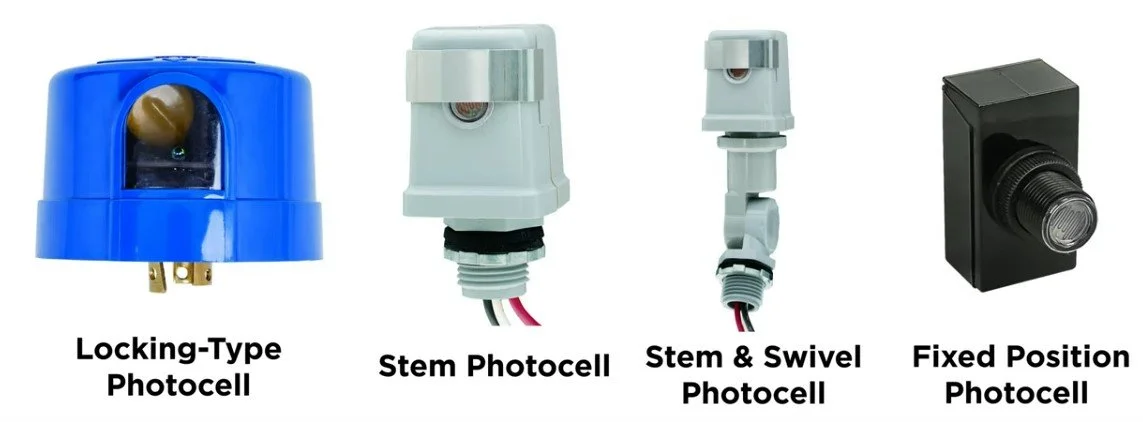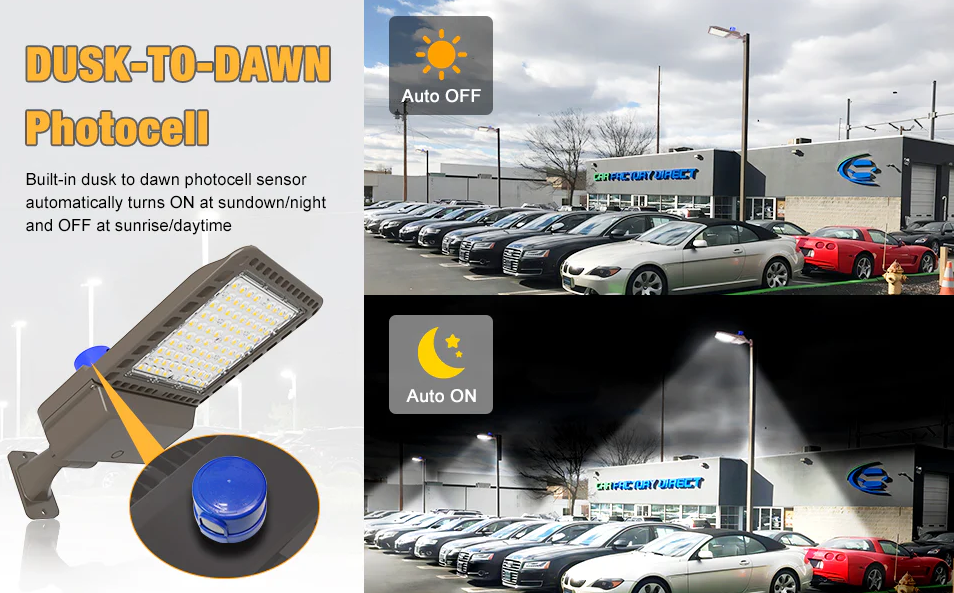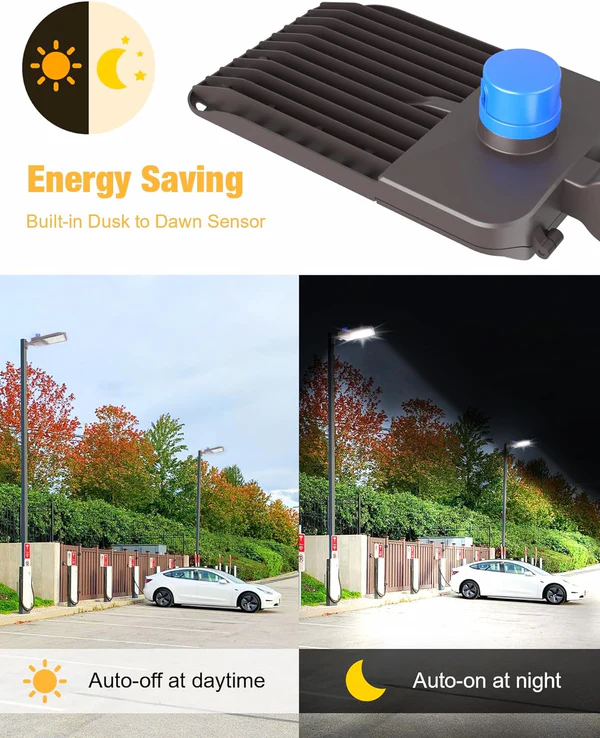Home >> News >> Industry News
A photocell is a circuit element inside the ambient light sensor (ALS) that converts incident radiant energy into an electrical signal for daylight harvesting or dusk-to-dawn control. It’s also referred to as a photosensor or photocontrol which, however, technically describes the whole sensing system. A typical photosensor or photocontrol is comprised of a photocell along with a controller which implements the conversion and communication logic. It controls luminaire operation to achieve additional energy savings in response to the amount of natural daylight detected. A photocell can produce an electrical current or resistance proportional to the amount of light that strikes it. When the change in photocell illuminance exceeds an established threshold, a photosensor signal is generated to control either a directly interfaced luminaire or a group of luminaires that are network connected and designated with a common zone address.

The role of electric lighting in daylighted spaces, regardless of whether they’re indoor or outdoor areas, is to complement daylight during daytime and deliver the required illuminance during nighttime. Minimizing energy consumption and reducing carbon footprint are two apparent benefits of daylighting. In indoor environments, the presence of daylight can also support visual needs and offer significant physiological and psychological benefits. Daylight harvesting, which refers to the adjustment of electric lighting based on available daylight, is a prime consideration in building and space design. This control strategy uses information provided by photosensors as input to controllers, which then use algorithms to adjust lighting levels in discrete steps (on/off switching), in large, perceptible increments (step dimming), or in small, imperceptible steps (continuous dimming). A similar concept known as dusk-to-dawn control is commonly used in outdoor lighting, where outdoor wall lights, security lights, street lights and area lights are turned on at dusk and off at dawn based on real-time measurements of daylight levels.
Daylighting control strategies may be implemented using “open loop” or “closed loop” systems. In an open-loop control system, the photosensor does not react to changes other than the outside daylight level. It accounts for sky conditions and is not influenced by the electric lighting that it is controlling. Outdoor photocontrols are always open loop since they serve only to trigger a system action and switch lighting between dusk and dawn. Open loop systems also find their use in interior applications where daylighting is used only to address basic visual requirements and does not need to consider the dynamic nature of daylight. Closed loop systems are generally utilized in indoor installations where visual comfort and task performance are of paramount importance. In a closed loop system, the photosensor must be located within the zone that it is controlling and so it is affected by both daylight and electric lighting. The closed loop system detects both daylight and electric light, and has the ability to adjust for sky conditions which fluctuate over the course of the day due to the continuous apparent movement of the sun and the changes in atmospheric conditions. Based on the measured illuminance, it dynamically adjusts the lumen output of the electric lighting systems to maintain an optimum luminous environment.
Photocells employ varying mechanisms for daylight detection. Photoemissive detection is based on the photoelectric effect, in which electrons are emitted from the surface of, generally, a metal upon its absorption of radiant energy. The sensing element is either an evacuated or gas-filled tube made up of a cathode and one or more anodes. Photoconductive detection makes use of the ability of a material to conduct electricity as a function of the intensity of the incident light. Photovoltaic detection uses the photovoltaic effect of a semiconductor p-n junction, which converts incident photons of solar light into electricity. A photodiode is also a p-n junction which can convert light into an electric current. Phototransistors can be viewed as photodiodes with some internal amplification. Thermal detection involves heating a material with a temperature-dependent electrical resistance.
Photocells in common use are generally fabricated from semiconductor materials. Historically, cadmium sulfide (CdS) and cadmium selenide (CdSe) were employed in photocells due to their high photoconductive gain, high spectral sensitivity in the spectral region of interest, high quantum efficiency, and high-speed, low-noise response. However, these photoconductive cells are electro-mechanical or magnetic devices which cannot afford accurate turn-on and turn-off control. Moreover, cadmium is a RoHS-restricted material.

Today, electronic photocontrols made with photodiodes, phototransistors or photo ICs have become the mainstream. Photodiodes are silicon p-n junctions. The photoresponse of a photodiode is a function of the photogeneration of electron-hole pairs, which produces a small electrical current (photocurrent) in proportion to the amount of incident light. Photodiodes can operate with a high speed and linearity of response. These devices can be calibrated to provide extremely accurate measurements. Their spectral response characteristics can be tuned by manipulating the band gap energy of the materials forming the active region. Silicon photodiodes have a low visible-light sensitivity and require external amplification circuit to bring the weak photocurrent signal to a useful level.
A phototransistor, with a current amplification mechanism provided by the bipolar NPN transistor, has a sensitivity that is 50 to 100 times greater than that of a photodiode. Nonetheless, its useful operating frequency is limited to a few hundred kilohertz due to the larger junction capacitance. A photo IC integrates a photodiode, amplifier, schmitt trigger circuit, and output transistor into one package to allow operation just as easy as using a photodiode and provide spectral response close to human eye sensitivity, while offering a high current output comparable to phototransistors.
Photosensors are either component-level modules or standalone devices. Component-level modules are usually designed for single-light control, whereas standalone devices can be used to exercise control over a lighting zone which can be assigned with any number of luminaires. Component-level modules can be analog or digital ALS devices depending on whether an analog-to-digital converter (ADC) is integrated. The voltage output of an analog sensor is either applied to the input of an ADC interface on a microcontroller (MCU) or directly used as an input to an LED driver IC.

The on-chip ADC of a digital sensors produces digital data of a desired conversion resolution which can be 8 bits, 10 bits, 12 bits, 16 bits, 24 bits, or even 32 bits. The digital output allows direct connection to the MCU of an LED luminaire via a board-level interfacing technology such as interintergrated circuit (I2C) and serial peripheral interface (SPI). A standalone device is frequently an embedded system that incorporates an ADC to convert data into a digital format, thus making it usable by the microcontroller. The embedded system also comes with a communication interface that allows it to send and receive information to and from other external devices.